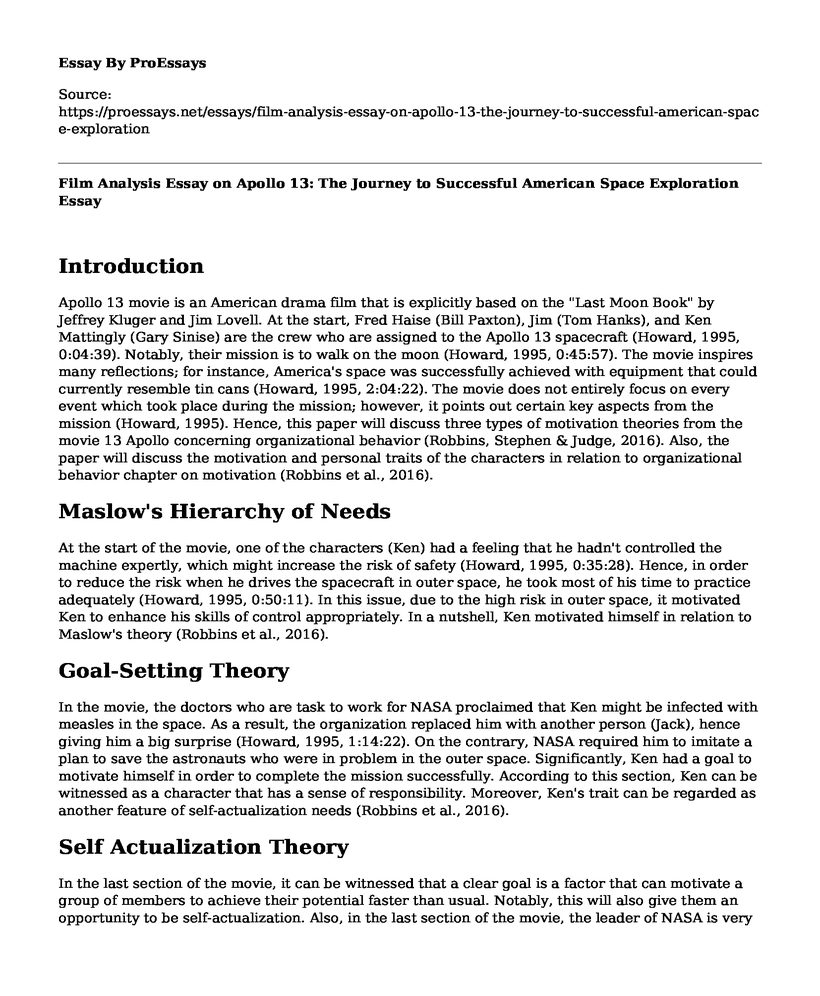Introduction
Apollo 13 movie is an American drama film that is explicitly based on the "Last Moon Book" by Jeffrey Kluger and Jim Lovell. At the start, Fred Haise (Bill Paxton), Jim (Tom Hanks), and Ken Mattingly (Gary Sinise) are the crew who are assigned to the Apollo 13 spacecraft (Howard, 1995, 0:04:39). Notably, their mission is to walk on the moon (Howard, 1995, 0:45:57). The movie inspires many reflections; for instance, America's space was successfully achieved with equipment that could currently resemble tin cans (Howard, 1995, 2:04:22). The movie does not entirely focus on every event which took place during the mission; however, it points out certain key aspects from the mission (Howard, 1995). Hence, this paper will discuss three types of motivation theories from the movie 13 Apollo concerning organizational behavior (Robbins, Stephen & Judge, 2016). Also, the paper will discuss the motivation and personal traits of the characters in relation to organizational behavior chapter on motivation (Robbins et al., 2016).
Maslow's Hierarchy of Needs
At the start of the movie, one of the characters (Ken) had a feeling that he hadn't controlled the machine expertly, which might increase the risk of safety (Howard, 1995, 0:35:28). Hence, in order to reduce the risk when he drives the spacecraft in outer space, he took most of his time to practice adequately (Howard, 1995, 0:50:11). In this issue, due to the high risk in outer space, it motivated Ken to enhance his skills of control appropriately. In a nutshell, Ken motivated himself in relation to Maslow's theory (Robbins et al., 2016).
Goal-Setting Theory
In the movie, the doctors who are task to work for NASA proclaimed that Ken might be infected with measles in the space. As a result, the organization replaced him with another person (Jack), hence giving him a big surprise (Howard, 1995, 1:14:22). On the contrary, NASA required him to imitate a plan to save the astronauts who were in problem in the outer space. Significantly, Ken had a goal to motivate himself in order to complete the mission successfully. According to this section, Ken can be witnessed as a character that has a sense of responsibility. Moreover, Ken's trait can be regarded as another feature of self-actualization needs (Robbins et al., 2016).
Self Actualization Theory
In the last section of the movie, it can be witnessed that a clear goal is a factor that can motivate a group of members to achieve their potential faster than usual. Notably, this will also give them an opportunity to be self-actualization. Also, in the last section of the movie, the leader of NASA is very confident as well as decisive by transferring the positive energy to his subordinates (Howard, 1995, 1:32:55). Through this, the NASA Gene sets himself as an example to his subordinates through encouraging them to complete their own work in time. In a nutshell, managers should ensure that every single individual has the ability as well as the required support to attain their outcomes. According to (Robbins et al., 2016), managers should give the subordinates or team members confidence in their job, as witnessed in the case of Gene, the NASA leader.
Key Teaching Point Learned From This Movie
From the movie, the managers of the current corporations and organizations are irreplaceable. As a result of this, they will lead the subordinates as well as the teammates in achieving their goals. Thus, the implication for a manager from the film "13 Apollo" is a representative example of motivation (Howard, 1995). Notably, an institution comprises of many sorts of teammates. Therefore, the important goal for every manager is to find a way in which to integrate all these people together as one. Moreover, as a successful leader, a manager should differentiate various types of subordinates; hence, he can implement different policies in order to motivate the workers/ teammates (Robbins et al., 2016).
Surprising or Unexpected Event from the Movie
In the second section of the movie, the motivation theory of goal setting has been used (Howard, 1995, 1:05:59). In this theory, a certain group of members not only concern about their safety but also their set goals, something surprising. Moreover, a number of these people have a perception that easy jobs cannot bring happiness, which is another instance surprising as well. Surprisingly, some group members needed better jobs, which are full of challenges in order to realize their value.
Conclusion
In summary, according to the three sections of the film that has been discussed effectively in the paper, it can be concluded that motivation is an indispensable part and parcel of management. Thus, in every group or organization, motivation is a factor that can cause the work efficiently.
References
Howard, R. (1995). Apollo 13 [Motion picture]. Los Angeles, CA: Universal Pictures.
Robbins, Stephen. P. & Judge, T. A. (2016). Organizational Behavior 17th Edition. England.
Cite this page
Film Analysis Essay on Apollo 13: The Journey to Successful American Space Exploration. (2023, Apr 10). Retrieved from https://proessays.net/essays/film-analysis-essay-on-apollo-13-the-journey-to-successful-american-space-exploration
If you are the original author of this essay and no longer wish to have it published on the ProEssays website, please click below to request its removal:
- Research Paper Example on Science Effort to Reassure Public Trust in Non-propaganda Use of Vaccine
- Miles Davis Biographical Essay Example
- Compare and Contrast Essay on Paul Revere From the Movie Sons of Liberty and Real Life
- Film Analysis Essay on His Girl Friday (1940)
- The Golden Age of Japanese Cinema: 1950s Post-War Prosperity - Research Paper
- Fashion Companies Lack Clear Ethical Standards: What Does Sustainability Mean? - Essay Sample
- Free Essay Sample on Substance Use







